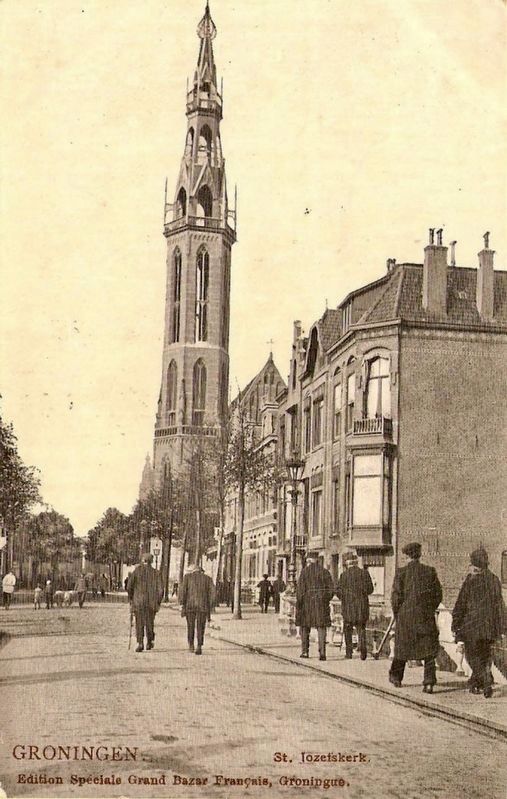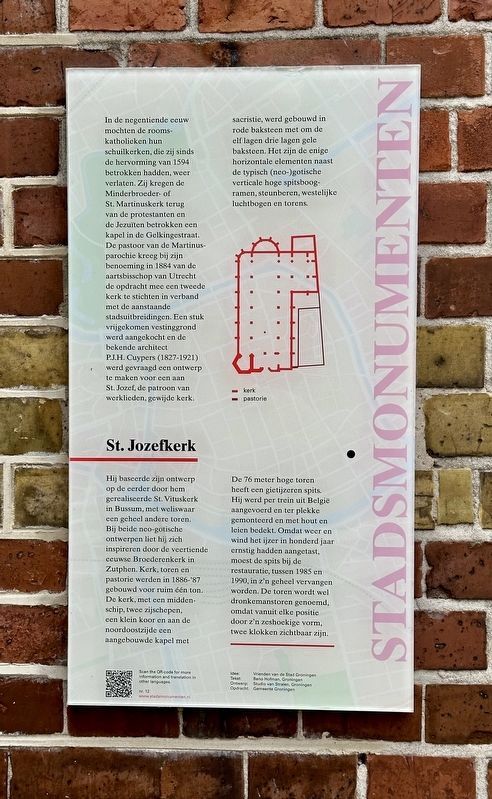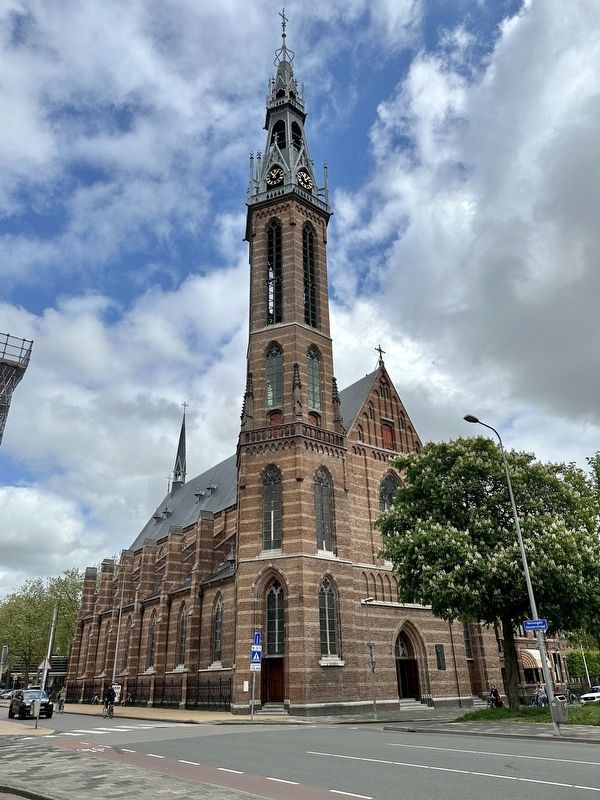Groningen, Netherlands — Northwestern Europe
St. Jozefkerk / St. Joseph Church
— Stadsmonumenten —
Hij baseerde zijn ontwerp op de eerder door hem gerealiseerde St. Vituskerk in Bussum, met weliswaar een geheel andere toren. Bij beide neogotische ontwerpen liet hij zich inspireren door de veertiende eeuwse Broederenkerk in Zutphen. Kerk, toren en pastorie werden in 1886-’87 gebouwd voor ruim één ton. De kerk, met een middenschip, twee zijschepen, een klein koor en aan de noordoostzijde een aangebouwde kapel met sacristie, werd gebouwd in rode baksteen met om de elf lagen drie lagen gele baksteen. Het zijn de enige horizontale elementen naast de typisch (neo)gotische verticale hoge spitsboogramen, steunberen, westelijke luchtbogen en torens.
De 76 meter hoge toren heeft een gietijzeren spits. Hij werd per trein uit België aangevoerd en ter plekke gemonteerd en met hout en leien bedekt. Omdat weer en wind het ijzer in honderd jaar ernstig hadden aangetast, moest de spits bij de restauratie, tussen 1985 en 1990, in z’n geheel vervangen worden. De toren wordt wel dronkemanstoren genoemd, omdat vanuit elke positie door z’n zeshoekige vorm, twee klokken zichtbaar zijn.
In the nineteenth century, the Roman-catholics were allowed to leave their hidden churches again, which they used since the reformation in 1594. They got back the Minderbroeder- or St. Martinus church of the protestants and the Jesuits occupied the chapel in the Gelkingestraat. The pastor of the Martinus parish got, with his nomination in 1884, an order of the archbishop of Utrecht to found a second church connecting to coming city expansions. A piece of land became vacant and was bought, and the famous architext P.J.H. Cuypers (1827-1921) was asked to make a design for a church dedicated to St. Jozef, the patron of workers.
He based his design on a St. Vitus church
in Bussum which was realized by himself, with indeed a complete other tower. Both neo-Gothic designs were inspired by the fourteenth century Broederen church in Zutphen. The church, tower and rectory were built for a large ton in 1886-’87. The church, with a middle ship, two side ships, a little choir and at the north-east side a built-on chapel with sacristy, was built in red bricks with every eleven layers, three layers of yellow bricks. There are some horizontal elements next to the typical (neo) Gothic vertical high pointed arch windows, buttresses, westerly flying buttresses and towers.
The 76 metres high tower has a cast-iron top. It was supplied by train from Belgium and assembled on site and with wood and slate covered. Because bad weather seriously harmed the iron in hundred years, the top had to be completely replaced at the restauration, between 1985 and 1990. The tower is surely called drunks tower, because from every position through its form of six squares, there are two clocks visible.
Erected by Gemeente Groningen. (Marker Number 12.)
Topics and series. This historical marker is listed in this topic list: Churches & Religion. In addition, it is included in the Groningen Stadsmonumenten series list. A significant historical year for this entry is 1594.
Location. 53° 12.879′ N, 6°

Photographed By Edition Speciale Grand Bazar Francais, Groningen, circa 1910
3. St. Jozefkerk
The marker text finishes by noting that the church tower might well be called “drunk’s tower”, as due to the six-sided form of the tower, there are always at least two clocks visible (see photo 2). This was not always the case, as this century old postcard shows a lack of clocks. Postcards of the church from the 1950’s, however, do show the clocks.
Other nearby markers. At least 8 other markers are within walking distance of this marker. Heresingel 13 (about 90 meters away, measured in a direct line); Herestraat 106 (approx. 0.2 kilometers away); Hereplein 4-5 (approx. 0.3 kilometers away); Oosterstraat 44 (approx. 0.3 kilometers away); Bentelaarsgang (approx. 0.4 kilometers away); De Toekomst / “The Future” (approx. half a kilometer away); Tuinkoepel Scholten (approx. half a kilometer away); Synagogue (approx. half a kilometer away). Touch for a list and map of all markers in Groningen.
Credits. This page was last revised on May 25, 2023. It was originally submitted on May 25, 2023, by Andrew Ruppenstein of Lamorinda, California. This page has been viewed 35 times since then and 3 times this year. Photos: 1, 2, 3. submitted on May 25, 2023, by Andrew Ruppenstein of Lamorinda, California.

